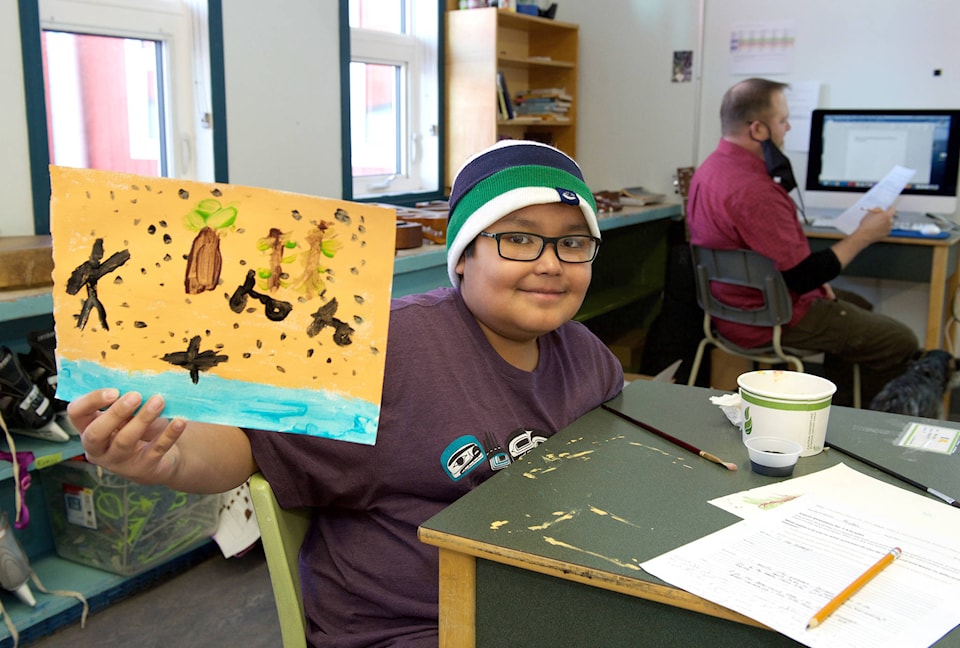A youth art exhibition in Carcross, How We Walk with the Land and Water, is encouraging local children to consider their connection to the land.
Colleen James — a local knowledge keeper, advisor on the project and auntie to many — presents the art as evidence of the youths’ wisdom.
“These little ones are making connections and going even deeper than we would have liked; they are conscious of their footprint even in kindergarten,” James said.
| Sandra Storey, Curator of Haa Shagoon Hidi sets up the How We Walk with the Land and Water Kids Postcard Exhibit that describes what is important to the students in the Ghùch Tlâ Community School in Cacross on the land and water. The exhibit runs until the end of August. (Courtesy/Anna Crawford) |
James points to the artwork of the children currently on display in two Carcross venues: Haa Shagoon Hidi (formerly Learning Centre) and the Caribou Crossing Coffee Shop in the Carcross Commons. These exhibits are one small part of the larger How We Walk with the Land and Water endeavour.
“See this little kindergarten kid who is making pathways on the side of the road, like they were totally conscious of road kill. She is reminding us that the animals have a right to walk safely too!”
Another child, Sahale Gatensby, when asked why she had put a stop sign in the forest, said, “It was so people would remember not to disturb the sleeping bears.”
James says that by drawing those pictures, “it was deeper than just Indigenous knowledge.” It reflects current considerations. It is “current knowledge at play.”
| Thomas Fawcett (left) a full-time carver for the Carcross / Tagish First Nation, assists Sahale Gatensby (right) on how to draw trees. Sahale explains why she painted a stop sign beside her skating, "it's so people know not to interrupt the sleeping bears." (Courtesy/Anna Crawford) |
Last March, the school children at Ghùch Tlâ Community School in Carcross heard traditional stories and discussed what was important to them. Afterwards, the children drew and painted with the assistance of Thomas Fawcett, one of two full-time carvers with the Carcross/Tagish First Nation. The children were asked to think about what they valued.
One mid-grade student struggled and James talked with him about Together Today for Our Children Tomorrow, the founding document for modern land claims agreements in the Yukon. The boy thought, then wrote, “Together today for our community tomorrow.”
Is there a message? James says “It is really, ‘out of the mouths of babes.’ It makes that much more powerful—meaningful.”
Elders from three Yukon Fist Nations deliberately named the initiative How We Walk with the Land and Water to indicate a process of building relationships.. In Tlingit it is called, Aat á x yaa has na.át. aáni ka heen; in southern Tuchone, Na̋n ye chu ye ts’àdnäl.
| Sahale Gatensby says, "I put a stop sign in my painting so we don't interrupt the sleeping bears. I also love skating with my mom. It makes me happy!" (Courtesy/Anna Crawford) |
“It is about doing things differently,” the project’s engagement and communications coordinator, Anna Crawford writes. “It’s a process about relationships between multiple First Nations governments, between people and nature, between people and their culture. It’s about art and culture and how culture connects us to the land. It’s about adaptation, expressing old beliefs through new mediums, and letting traditional knowledge direct technical work.”
The project engages elders, anthropologists, carvers, scientists, citizens, mappers and children, synthesizing information, creating art, sitting around fires, talking, learning and understanding. It is framing relational understandings for regional land use planning, expected in the near future.
The children’s paintings were turned into postcards and mailed to their homes. It was a way of bringing school and home together. Soon, carvers will make four panels about food in different seasons, as part of another piece of the broad initiative. It is all connected.
How We Walk with the Land and Water is about how we value our relationships. It is a relationship initiative, building understanding between generations, amongst the three first nations, and, with and on the land.
Sometimes, it is the children who frame things best.
Contact Lawrie Crawford at lawrie.crawford@yukon-news.com
